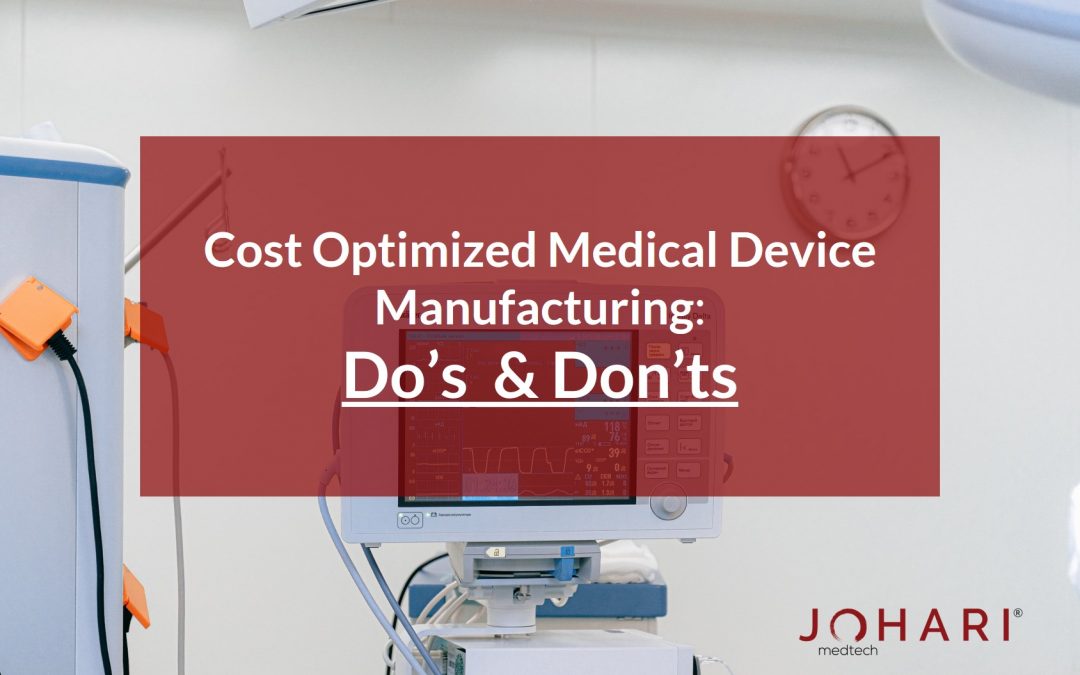Medical Device Manufacturers face increasing pressure on keeping manufacturing cost-optimized. Strategic measures are required to keep the price competitive without putting quality, usability, and functionality at stake. The high cost, complex technologies, stringent regulatory laws, cybersecurity concerns of new-age medical devices demand manufacturers to cope with the tough challenge of the balancing act between innovation and cost optimization. To understand the dynamics and problems better let’s, explore more cases and ways to optimize cost of Medical Device Manufacturing.
Keeping Cost & Usability synchronized
While new technologies are fascinating, it’s important to remember that mere addition of a new technology or feature doesn’t always guarantee success. Cost reduction should not lead to getting a cheaper replacement that affects the crucial functionality of the product. Additionally, it is important to analyze the market including the gatekeepers, users, and trainers before making any change. A shallow and non-directional approach can lead to product recalls or legal claims due to product failure. To understand this better here is a quick case to consider.
Case 1
A pacemaker manufacturing firm developed a simpler version of a complex device to make it more accessible and affordable. The cost was reduced by replacing the programmable controls with mechanical controls but, the acceptance rate fell dramatically. Replacing the conventional programmable control with an electro-mechanical version the developers thought they could provide a potential solution to the middle-class looking for an affordable device. But challenges encountered which led to non-acceptance were,
- Firstly, the insecurities of Mechanical controls led to the fear of numerous secondary procedures and operations.
- Secondly, surgeons (the gatekeepers for the process) were officially trained with programmable pacemakers which made it difficult to accept such a critical change.
The case evidently supports that it’s important to perform a critical analysis of the market in multiple ways before reaching a conclusion. Anything modern or advanced in terms of technology might draw attention but it may not offer the comfort end user has experienced in the previous versions.
Design to Value Equation
Clean Sheet Analysis
The clean sheet analysis involves analyzing the open data sources, external third-party sources, and internal data sources to optimize the cost involved at different phases. The analysis of data sources provides insights to craft strategies to get minimum procurement costs. This also involves design analysis to identify aspects where cost-cutting is possible. For instance, for an Electronic Medical Device Manufacturer, clean sheet analysis reveals possible ways to reduce cost like deducting number of PCBs or batteries or simply changing the enclosure material, shape or size.
Tearing it down
The success of the existing product may leave blind spots that hamper cost optimization in a longer run. Comparing the product with other similar products in competition exposes many areas where cost optimization is possible. The modifications could be in terms of housing, power supply, utility, branding, and so on. A teardown is not only required for cost-cutting but also helpful in suggesting product improvement relevant to industry demands.
Case 2
A medical manufacturing company building blood pressure monitoring system compared its product with a similar existing product in competition. Point-to-point evaluation of the features, manufacturing processes, and other aspects revealed more than 20 areas where changes could be done to optimize the cost and boost functionality. Some common amendments that could be done to bring down the cost were:
- Minimizing the complexity of the packaging & printed materials
- Switching to low cost yet high-quality batteries
- Modifying the housing and casing by reducing the thickness of the material used
Keeping these amendment areas in mind the developers modified the design by adding extra storage space and mounting the device over a supporting panel. The device sale was affected and developers had to rethink what went wrong.
After digging deeper, they found that a handy, elegant design of a BP monitor is more attractive to the user than a mounted model having drawers offering extra storage. Unnecessary fancy features add to manufacturing cost. It’s important for designers & developers to consider the sales and marketing data while inventing or modifying a product. It’s important to keep the human factor & technology balanced to deliver what user’s need and cherish.
The design to value approach focuses on incorporating human factors into the medical device designs. As a Global Medical Device Contract Manufacturer Johari, Digital Healthcare understands what it takes for a device to survive in a price-sensitive market. Making customer-centric devices at optimized cost offers a critical competitive advantage and boosts overall revenue.
Johari Digital is a global medical device contract manufacturing company with 40+ years of expertise. The manufacturing facility is in compliance with MDSAP, ISO 13485:2016 and FDA (21 CFR 820) standards and processes. Their services range from design to development, electronics and mechanical engineering, prototyping, system integration, packaging and supply chain. Additionally, Johari also helps clients with regulatory and compliance support to quickly take their product to market.
Schedule a Consultation with Johari Digital Healthcare Ltd. for a seamless manufacturing experience.



Trackbacks/Pingbacks